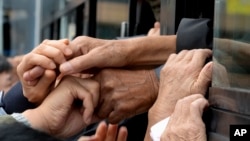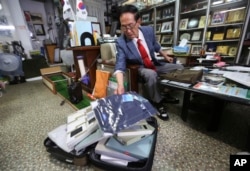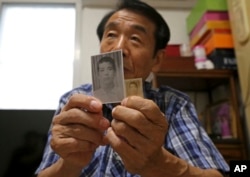Won Yun last saw his grandmother and sisters on the banks of the Taedong River during the January Fourth Retreat of the Korean War. Eventually, Yun, his grandfather, parents and three brothers made it to the South, while his grandmother and two younger sisters remained.
The 8-year-old Yun believed the entire family would reunite after the war. They could not.
Like thousands of other Korean-Americans, Yun, now 76, yearns to be reunited with relatives in North Korea.
Hopes raised
For many of them, the recent summit meeting between President Donald Trump and North Korea’s Kim Jong Un raised the hope of family reunions.
“[Korean-American divided families are] the last living human link between the U.S. and DPRK,” said Jason Ahn, board chair of the Divided Families USA (DFUSA). He referred to North Korea by its official name, the Democratic People’s Republic of Korea. “This is a humanitarian issue and we need to act quickly to resolve this as soon as possible.”
Since the Korean War split the Korean Peninsula in 1950, an estimated 100,000 Korean-Americans have been cut off from relatives in North Korea.
While the U.S. and North Korea do not have a formal reunification channel for Korean-Americans and their North Korean relatives, since 2000, North and South Korea have held 20 reunions for their divided families, both physically and virtually. The next is scheduled for Aug. 20-26 at North Korea’s Diamond Mountain resort.
The greatest deterrent to reuniting Korean-Americans and their North Korean families has been the tense relationship between the U.S. and North Korea, now warming somewhat, and the precedence of the denuclearization issue.
“I’ve argued that human rights issues ought to be part of any conversation that the United States has with North Korea,” said Ambassador Robert King, the former special envoy for North Korean human rights issues in the Obama administration, adding that denuclearization is “an extremely important issue … and there’s no question that it’s the most important.”
But the divided families issue cannot wait.
“These [divided family members] … they’re all in their 70s, 80s, they’re all going to die,” Yun’s son, David Yun, said. “So that 100,000 is no longer 100,000 anymore.”
DFUSA and its partner organization, the National Coalition for the Divided Families (NCDF), each keep a registry of Korean-Americans with family members in North Korea.
Within the last year, several Korean-Americans on the registries have died. Others decided they no longer wanted to be registered. Some just fell off the radar.
“We need to be prioritized … even before normalization [of relations between the U.S. and North Korea] or even before the nuclear issue is resolved,” Ahn said. “That may take many years and … people are dying. Literally dying.”
Tracking down relatives
Some Americans have made their own way to North Korea. That’s what Heang Ki Paik did.
A 69-year-old taekwondo master who lives in San Francisco, Paik is the son of a North Korean mother and a South Korean father who married before the Korean War. Paik, his parents and his five brothers fled to the South in 1951, leaving behind his mother’s side of the family.
“My mother … spoke in a North Korean dialect, and everyone knew that she was North Korean,” so she was discriminated against in the South, Paik said in a translated interview with VOA.
When Paik’s mother died in 1991, she left him the last known addresses of her North Korean family.
Paik moved to the U.S. in 1992 and began seeking her family.
Fifteen years later, in October 2007, Jung Woo-jin, a Korean-American taekwondo grandmaster and publisher of Taekwondo Times, hosted North Korea’s national Taekwondo Demonstration Team to perform and tour five cities in the U.S. The North Korean group consisted of 18 taekwondo athletes and seven officials.
Among them was Ung Chang, who represents Pyongyang on the International Olympic Committee.
Paik, who coordinated the event in San Francisco, stuck close to Chang over the course of three days.
“I knew this person was my only chance, so I worked hard to become friendly with him,” Paik said. On the meeting’s last day, he asked Chang to find his mother’s relatives.
Three months later, a U.N. representative for North Korea contacted Paik and confirmed that his aunt and uncle were alive.
Three years later, on Oct. 22, 2010, in his mother’s hometown Nampo, Paik met his family and spent three days with them.
Other avenues
Other divided Korean-American families seek different avenues.
Yun’s parents never gave up looking for their daughters. When they died, Yun, who had been living in the U.S. since 1965, continued their quest. He contacted a Canadian organization that said they had located his sisters.
“I was very skeptical … I think that’s the feeling that everyone had,” said David Yun, whose doubts failed to deter his father.
On Oct. 13, 2007, Yun flew to Pyongyang, then trekked to Anju. There, at a four-story hotel, he opened the door to a room and his younger sisters, Won Bok and Won Sil, flew into his arms.
Yun, who documented his time in North Korea, showed the videos to his family in New Jersey when he returned.
“Our jaws dropped, because this lady was the spitting image of my grandmother,” David Yun said in reference to Won Bok, the older sister. “It was as if my grandmother rose up from the dead and she was living in North Korea.”
Although Paik and Yun were able to reunite with their families, thousands of Korean-Americans remain frustrated.
Third-party organizations, brokers or black marketers often demand tens of thousands of dollars from those seeking their families. Sometimes people are cheated of their money.
“[The divided families] went from one broker to another to hoping the next time would be … successful to find out whether their parents were still alive,” said Chahee Stanfield, NCDF’s executive director.
Although legislation for divided families has been introduced and passed under the Bush and Obama administrations, they did not yield the formal mechanism for reunions that the families and their advocates want.
When VOA asked about the possibility of the Korean-American divided families being discussed with North Korea, the U.S. State Department referred to the first point in the Singapore statement that the “United States and the DPRK commit to establish new U.S.-DPRK relations in accordance with the desire of the peoples of the two countries for peace and prosperity.”
In June, Democratic Congresswoman Karen Bass of California introduced a resolution that would require the U.S. government to hold a reunion within 60 days of the resolution’s passing.
In accordance with the binding nature of the resolution, which is with the House Committee on Foreign Affairs, Bass believes that reunions should not be dependent on the United States’ relationship with North Korea.
“I think reunification should happen. Period,” she said in an interview with VOA.
Pushing for more
Stanfield, NCDF’s executive director, appreciates the congresswoman’s resolution and wants the Trump administration to do more.
“DFUSA [has] met high-ranking officials at the vice president’s office, the president’s office — the people we have met are in the decision-making positions,” Stanfield said. “So right now, we appreciate … the resolution, [but] we have passed … that stage. Long time ago.”
Hannah Y. Kim, who wrote the Divided Families Bill that passed Congress in 2016 as the chief of staff to former Congressman Charles Rangel, believes resolutions are not sufficient.
“It’s not enough for a politician or an elected official to introduce a bill,” Kim said. “That doesn’t mean anything unless people do something about it, keep on raising the issue. And that has to be led by Korean-Americans.”
Organizations like the Council of Korean Americans (CKA) and the Korean American Grassroots Conference (KAGC) urge Korean-Americans to raise the issue with their Congressional representatives.
“Part of what we’re trying to do at CKA is to educate our community around the power that we wield,” Interim Executive Director of CKA Jessica Lee said. “Until we have more people doing that with this [divided families] issue, I think it’s going to be difficult to make the … progress that we all want.”
Ahn, who has been involved with the divided families issue for 12 years, looks at the success of the repatriation of remains from North Korea and wants the same for the divided families.
“Really, with a handshake … between President Trump and Chairman Kim, it could happen,” Ahn said. “They just need to declare it and it will happen.”
Hannah Kim recognizes that facilitating a meeting for thousands of families has its challenges.
“At the very least, let’s do a virtual [reunion]. … Nothing, nothing, nothing will be better of course than being united in person, to be able to hug and kiss and talk to each other,” she said. “But just knowing … that they’re even alive on the other end of the screen, sometimes that’s just good enough for them.”















